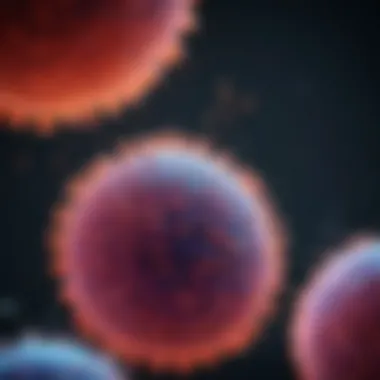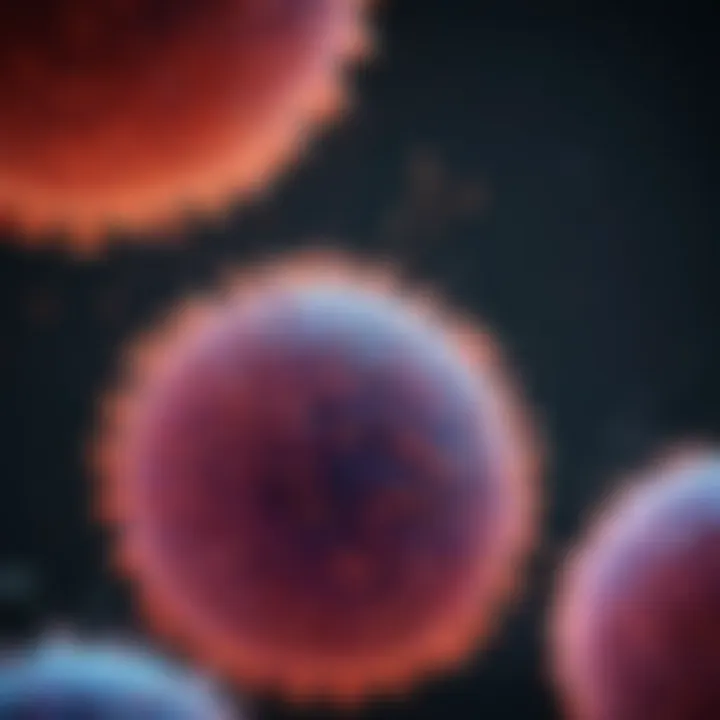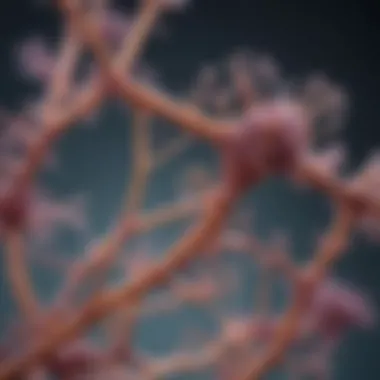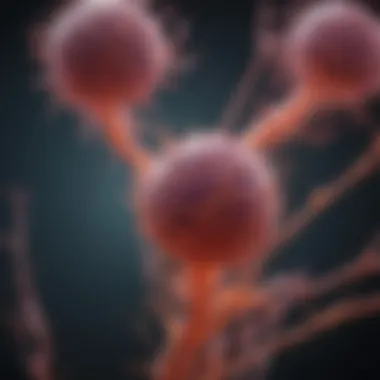Endosome Markers in Fluorescence Microscopy


Intro
Endosome marker fluorescence has transformed the landscape of cellular biology by providing essential insights into intracellular processes. The intricate role played by endosomes in cellular trafficking and signal transduction necessitates a comprehensive understanding of the markers used to visualize these structures. Fluorescent markers enable researchers to trace and analyze the dynamics of endosomes in live cells, which is essential for studying diseases and cellular functions.
This article will examine recent advances in the field, focusing on both the new discoveries and technological innovations that have enhanced fluorescence microscopy. Furthermore, it will detail the methodologies employed in research involving endosome markers, including research designs and data collection techniques. The aim is to present a thorough and coherent narrative on the significance of fluorescent endosome markers in contemporary cellular research.
Prelims to Endosome Marker Fluorescence
The realm of cellular biology has evolved with advanced imaging techniques, crucial for understanding intricate biological processes. Among these techniques, fluorescence microscopy stands out for its ability to tag and visualize endosomes, which are essential organelles involved in various cellular functions. This section addresses the significance of endosome marker fluorescence and its role in scientific research, aiming to highlight specific elements regarding its importance, benefits, and critical considerations.
Definition of Endosomes
Endosomes are membrane-bound compartments within eukaryotic cells that function primarily in the trafficking and sorting of biomolecules. They originate from the invagination of the plasma membrane and play a pivotal role in endocytosis. There are different stages of endosomal development, which include early endosomes, late endosomes, and lysosomes. Early endosomes are involved in the initial sorting of internalized material, while late endosomes serve as intermediaries transitioning to lysosomal degradation. Understanding the specific roles of these compartments is crucial for appreciating their functions in cellular signaling, nutrient uptake, and pathogen degradation.
Importance of Endosome Markers in Research
Endosome markers serve as vital tools in research, allowing scientists to probe deeply into the mechanisms governing cellular dynamics. Their importance can be summarized as follows:
- Cellular Mapping: Endosome markers enable the spatial mapping of endosomes within cells. This spatial information is essential for studying cellular morphology and understanding how endosomal trafficking may influence physiological and pathological conditions.
- Tracking Processes: By labeling endosomes with specific markers, researchers can monitor processes such as endocytosis and exocytosis. This is particularly valuable when investigating the uptake of therapeutic agents or the spread of pathogens in host cells.
- Tool for Diagnostics: Endosomal markers have potential applications in diagnosing diseases linked to cellular transport abnormalities, including certain genetic disorders and cancers.
Mechanisms of Fluorescence in Endosome Markers
Understanding the mechanisms of fluorescence in endosome markers is crucial for advancing cellular research. Fluorescence microscopy serves as a powerful technique to visualize and analyze endosomal dynamics. By elucidating the precise processes behind this technology, researchers can optimize their methodologies, enhance imaging quality, and derive accurate conclusions from experiments. The interplay between fluorescent labels and endosomes provides insight into cellular functions and can help in identifying diagnostics and therapeutics.
Fluorescence Basics
Fluorescence is the emission of light by a substance that has absorbed light or other electromagnetic radiation. This process occurs when certain molecules, referred to as fluorophores, absorb energy and then re-emit it at a longer wavelength. The primary goal in fluorescence microscopy is to visualize specific cellular components through the selective labelling of these components. Key elements to consider in fluorescence include:
- Excitation wavelength and emission wavelength
- Quantum efficiency of fluorophores
- Signal-to-noise ratio
These aspects are essential for achieving clear images that portray the precise locations of endosomes within cells.
Types of Fluorescent Labels
Fluorescent labels are vital for imaging endosomes. The selection of the appropriate label can significantly influence the quality of results obtained from experiments. Three common types of fluorescent labels include fluorescent dyes, fluorescent proteins, and quantum dots. Each has distinct characteristics that make them more or less suitable depending on the specific application or research requirements.
Fluorescent Dyes
Fluorescent dyes are small organic compounds that fluoresce when exposed to specific wavelengths of light. Their small size allows easy diffusion into cells. A key characteristic of fluorescent dyes is their ability to emit a broad spectrum of colors, which can be advantageous in multiplexing, the simultaneous imaging of multiple targets. They are popular choices for their relatively low cost and availability in diverse formulations.
However, fluorescent dyes have some limitations. They can be prone to photobleaching, diminishing their signal quality over time. This property makes them less effective for long-term studies. Furthermore, they require careful handling to prevent cross-contamination.
Fluorescent Proteins
Unlike fluorescent dyes, fluorescent proteins are genetically encoded. They can be expressed within the living organism, allowing for the monitoring of cellular processes in real-time. A hallmark of fluorescent proteins is their versatility, including commonly used proteins like Green Fluorescent Protein (GFP) that can be utilized to visualize endosomal structures under various conditions.


The significant advantage of using fluorescent proteins is their ability to emit stable fluorescent signals over extended periods. This feature is beneficial for live-cell imaging. However, the necessity for genetic modification may limit their usability in certain experimental contexts.
Quantum Dots
Quantum dots (QDs) are nanometer-sized semiconductor particles that exhibit unique electronic and optical properties. They are highly efficient fluorescent labels, with a broad absorption spectrum and narrow emission peaks. The tunability of their emission spectra based on size makes them advantageous for multiplexed imaging applications.
One standout advantage of quantum dots is their resistance to photobleaching, which allows for prolonged imaging sessions. However, their relatively complex preparation and potential cytotoxicity raise concerns about their use in live-cell applications. Therefore, researchers must weigh benefits against potential drawbacks when selecting quantum dots for their studies.
The choice of appropriate fluorescent labels profoundly impacts the results of endosome marker fluorescence studies, making careful selection paramount.
Common Endosome Markers Used in Fluorescence Microscopy
Fluorescence microscopy plays a crucial role in cellular research, particularly in understanding endosomal dynamics. Common endosome markers are vital for visualizing and studying the highly dynamic and complex behaviors of endosomes in living cells. These markers help elucidate cellular processes like trafficking, signaling, and membrane recycling. In this section, we will explore key endosome markers, their unique features, and recent advancements in marker development to enhance imaging experiences.
Key Endosome Markers
Rab Proteins
Rab proteins are small GTPases that are essential for intracellular membrane trafficking. They are known for their specificity in regulating the stages of vesicular transport. One characteristic that sets Rab proteins apart is their presence on various endosomes, where they act as molecular switches. Their ability to recruit specific effector proteins makes them beneficial in tracking endosome dynamics.
Rab proteins have several advantages in fluorescence microscopy. They provide distinct signals that reflect the status of endosomal transport, helping scientists visualize the pathways that cargo takes within cells. However, a disadvantage is their potential for redundancy; multiple Rab proteins can operate in overlapping pathways, complicating data interpretation. Thus, understanding the specific functions of Rab proteins is essential for meaningful analysis.
Clathrin
Clathrin is a key protein in membrane trafficking through its role in forming coated vesicles. The primary characteristic of clathrin is its ability to polymerize into a triskelion shape, creating a basket-like structure on the cytoplasmic side of the membrane. This structure is crucial for the formation of vesicles that transport proteins and lipids between various cellular compartments.
The benefit of using clathrin as a marker is its involvement in well-characterized pathways like receptor-mediated endocytosis. This makes it a popular choice for researchers studying how cells internalize materials. While clathrin provides clear insights into these processes, it does have limitations. For instance, clathrin-dependent pathways do not account for all endocytic mechanisms, meaning it may not capture the entirety of endosomal dynamics.
Development of Novel Markers
As researchers continue to explore cellular mechanisms, the development of novel markers for endosome fluorescence is essential. Recent advances include engineered fluorescent proteins that offer enhanced brightness and photostability. These markers can provide clearer images and allow for longer observation periods without significant signal loss. Additionally, synthetic dyes designed for specific endosomal pathways are emerging as powerful tools for imaged studies.
Applications of Endosome Marker Fluorescence
Endosome marker fluorescence is a pivotal component in the realm of cellular biology. It provides researchers with the tools needed to visualize and understand complex processes within the cell. This section will elaborate on the various applications of endosome marker fluorescence, emphasizing its significance and advantages.
Cellular Trafficking Studies
Studying cellular trafficking is fundamental for understanding how substances move within cells. Endosomes play a crucial role in this process, acting as intermediaries during vesicular transport. Utilizing endosome markers for fluorescence microscopy allows scientists to trace these pathways effectively.
By tagging endosomes with fluorescent markers, researchers can observe the dynamics of endosomal maturation and cargo sorting in real-time. For example, Rab proteins serve as specific markers for distinct endosomal populations. Their unique presence helps visualize the different trafficking routes taken by various substances, including receptors, nutrients, and signaling molecules. This information is vital for comprehending cellular response mechanisms and metabolic processes.
Drug Delivery Research
Drug delivery systems aim to optimize the distribution of therapeutics within the body. Understanding how drugs interact with cellular structures, especially endosomes, is essential in this field. Endosome marker fluorescence is vital for tracking how drug-loaded nanoparticles or liposomes reach their targets within cells.


For instance, by using fluorescently labeled molecules that bind to specific endosomal compartments, researchers can measure the internalization and release patterns of drug carriers. It helps in determining the efficacy of formulations and improving designs for targeted therapies. Additionally, real-time imaging can reveal how modifications in the drug delivery system alter internalization efficacy and release kinetics, leading to advancements in treatment strategies, especially in cancer therapy.
Pathogen-Escape Mechanisms
The study of pathogens and their escape mechanisms is another critical application of endosome marker fluorescence. Many viruses and bacteria exploit the endocytic pathways to gain entry and replicate within host cells. Understanding these ways provides insight into how pathogens evade host immune responses.
By employing endosome markers, researchers can observe how pathogens like SARS-CoV-2 or HIV hijack endosomal machinery. For example, tracking the uptake and intracellular fate of these pathogens is essential to identify potential therapeutic targets. Fluorescence imaging allows for the assessment of the timing and locations of escape mechanisms. Such knowledge can lead to designing better vaccines or antiviral therapies that target these pathways effectively.
"Endosome marker fluorescence does more than provide visual insights; it fundamentally alters our approach to understanding cellular processes and disease mechanisms."
In summary, endosome marker fluorescence is indispensable across various research domains. From cellular trafficking studies to drug delivery optimization and pathogen behavior analysis, the implications of this technology are profound. Utilizing specific markers enables scientists to dissect the complexity underlying cellular interactions and responses systematically.
Challenges in Endosome Marker Fluorescence
Understanding the challenges that arise in endosome marker fluorescence is essential for researchers. Proper visualization of endosomes heavily relies on the markers used. However, several factors can affect the effectiveness of these fluorescent labels. By addressing specificity, sensitivity, and photobleaching, researchers can better navigate the complexities involved in this field, ultimately enhancing the quality of their findings.
Specificity and Sensitivity Issues
One foremost challenge involves specificity and sensitivity. Specificity refers to the ability of a marker to bind to its target, such as a particular endosome type, without interfering with other cellular components. On the other hand, sensitivity defines how well the marker can detect low amounts of endosomes, crucial for accurate imaging.
Fluorescent labels should selectively target endosomes without labeling other organelles or structures. When markers lack specificity, it can lead to ambiguous results. For instance, by mistakenly tagging lysosomes or other regions, the interpretation of data could be compromised.
Moreover, sensitivity plays a critical role. If a marker is not sensitive enough, it may miss detecting essential signaling pathways involving endosomes. This neglect can result in missed opportunities to understand cellular mechanisms, impacting overall research outcomes.
Photobleaching Effects
Photobleaching is another significant concern in fluorescence microscopy. This phenomenon occurs when a fluorescent molecule loses its ability to emit light due to prolonged exposure to the excitation source. As a result, photobleaching affects not only the intensity of the signal but also the duration for which live images can be captured.
Consequently, researchers might have to limit the duration or intensity of exposure to prevent losing important data. In some cases, this limitation could hinder real-time observations, which are vital for understanding dynamic cellular processes.
To mitigate photobleaching, strategies such as using alternate imaging techniques or optimizing the light exposure can be beneficial. Additionally, employing more photostable fluorescent markers, like specific quantum dots, may enhance the imaging reliability.
"Addressing specificity, sensitivity, and photobleaching tips the scales toward more effective endosome marker fluorescence research."
These challenges underscore the importance of meticulous planning and choosing the right markers. While these issues may present obstacles, they also offer opportunities for advancements in the field. Continued research into developing more reliable and robust fluorescent markers can help streamline the journey towards better understanding endosomal functions.
Future Directions in Endosome Marker Research
The future of endosome marker research is critical for enhancing our understanding of cellular dynamics. As techniques evolve, the potential for innovative applications increases. This section covers advancements in marker development and the integration of endosome marker fluorescence with other technologies.
Advancement in Marker Development
Research continues to refine and innovate endosome markers. The aim is to enhance specificity and reduce potential interference. New biochemical strategies may lead to the development of markers that can target specific endosomal subtypes. This is important because different endosomal compartments play distinct roles in cellular processes. Moreover, advancements in genetically encoded fluorescent proteins offer opportunities for better resolution. These proteins allow researchers to visualize endosomes in real-time without disrupting cellular function.
Considerations for future marker development include:


- Target specificity: Each marker must uniquely identify the endosome type.
- Stability: Markers should maintain their fluorescence over extended observation periods.
- Compatibility: New markers must work with existing fluorescence microscopy techniques.
Overall, the development of refined markers will facilitate improved understanding of cellular mechanisms.
Integration with Other Technologies
The integration of endosome marker fluorescence with other technologies enhances research capabilities. This combination can reveal deeper insights into cellular processes. Two technologies stand out: super-resolution microscopy and live-cell imaging.
Super-Resolution Microscopy
Super-resolution microscopy is a transformative approach that surpasses the limits of conventional microscopy. The key characteristic is its ability to resolve structures at the nanoscale. This technique allows scientists to observe endosomes in intricate detail. It is beneficial because it provides clearer images of endosome morphology and distribution.
The unique feature of super-resolution microscopy is its enhanced spatial resolution, often down to 20-30 nanometers. However, it comes with challenges. This technique can be complex and require extensive expertise. Additionally, it may involve longer imaging times, which could affect live cell studies. Despite these hurdles, the insights gained are invaluable for understanding endosomal dynamics.
Live-Cell Imaging
Live-cell imaging enables observation of cellular processes in real time. This characteristic is key, as it allows researchers to monitor endosome behavior dynamically. Live-cell imaging supports the understanding of endosomal trafficking and its role in various cellular functions.
A unique feature of this method is the ability to track cellular processes over time, capturing transitions and movements. However, live-cell imaging requires careful handling to ensure cell viability. There may also be limitations regarding resolution compared to fixed samples. Nonetheless, the real-time data provided informs many aspects of cellular biology, including drug delivery mechanisms and cellular responses to stimuli.
The incorporation of advanced imaging techniques with endosome markers sets a promising path for unraveling complex cellular behaviors.
Ending
Understanding the topic of endosome marker fluorescence is crucial for various applications in cellular research. This article highlights three central elements: the summary of key points, the need for continued investigation, and the anticipated advancements in the field.
Summary of Key Points
In essence, endosome markers serve a pivotal role in fluorescence microscopy. They allow researchers to trace cellular processes with precision. Key aspects include:
- Definition of Endosomes: These are membrane-bound compartments in cells crucial for sorting and transmitting proteins.
- Fluorescence Mechanisms: Understanding the principles of fluorescence aids in selecting the right markers for imaging studies.
- Types of Markers Used: Notable markers such as Rab proteins and Clathrin have specific applications in research.
- Challenges Faced: Issues like specificity and photobleaching can hinder effective imaging, highlighting the need for careful selection and testing of markers.
- Future Directions: Advancements in marker technology and integration with other imaging methods will enhance research capabilities.
The benefits of these insights underscore the importance of using appropriate endosome markers, which directly influences the quality of research findings.
The Importance of Ongoing Research
Continuous research in endosome marker fluorescence is essential. The landscape of cellular biology is ever-evolving; thus, ongoing investigations are key to understanding complex cellular behaviors. Areas requiring attention include:
- Marker Development: New markers can improve specificity and sensitivity, addressing current limitations.
- Technological Integration: Incorporating super-resolution microscopy and live-cell imaging offers promising avenues for new discoveries.
- Broader Applications: Expanding research could open doors in drug delivery systems, disease treatment strategies, and pathogen studies.
"Research is not just about finding answers; it is about developing new questions that lead to deeper understanding."
Key Literature on Endosome Markers
Within the field of endosome research, several pivotal studies and reviews have been published. These works contribute significantly to our understanding of endosome dynamics and their markers. Key literature typically includes primary research articles, comprehensive reviews, and technical reports. Here are some noteworthy considerations:
- Primary research articles present original data and findings about specific endosomal markers, often revealing novel insights into their functional roles.
- Review articles synthesize existing knowledge, offering a broader perspective of ongoing trends and challenges within the field.
- Technical reports detail methodologies and techniques, guiding researchers in best practices for utilizing fluorescent markers.
Some notable papers include:
- "The Role of Rab Proteins in Endosome Dynamics" - elucidates how different Rab proteins function in endosomal trafficking.
- "Clathrin-Mediated Endocytosis" - provides insight into the processes behind endocytosis and the markers involved.
- "Advances in Fluorescent Tagging for Cellular Tracking" - discusses the innovations in fluorescent labeling techniques over the years.
These references not only reinforce the credibility of the current article but also guide readers towards a more nuanced understanding of endosome marker fluorescence. With this foundation, continued research can be directed toward overcoming existing challenges and enhancing current methodologies. The evolution of knowledge in this field demonstrates the critical importance of ongoing research and collaboration among scientists, ultimately contributing to advancements in cellular biology.













